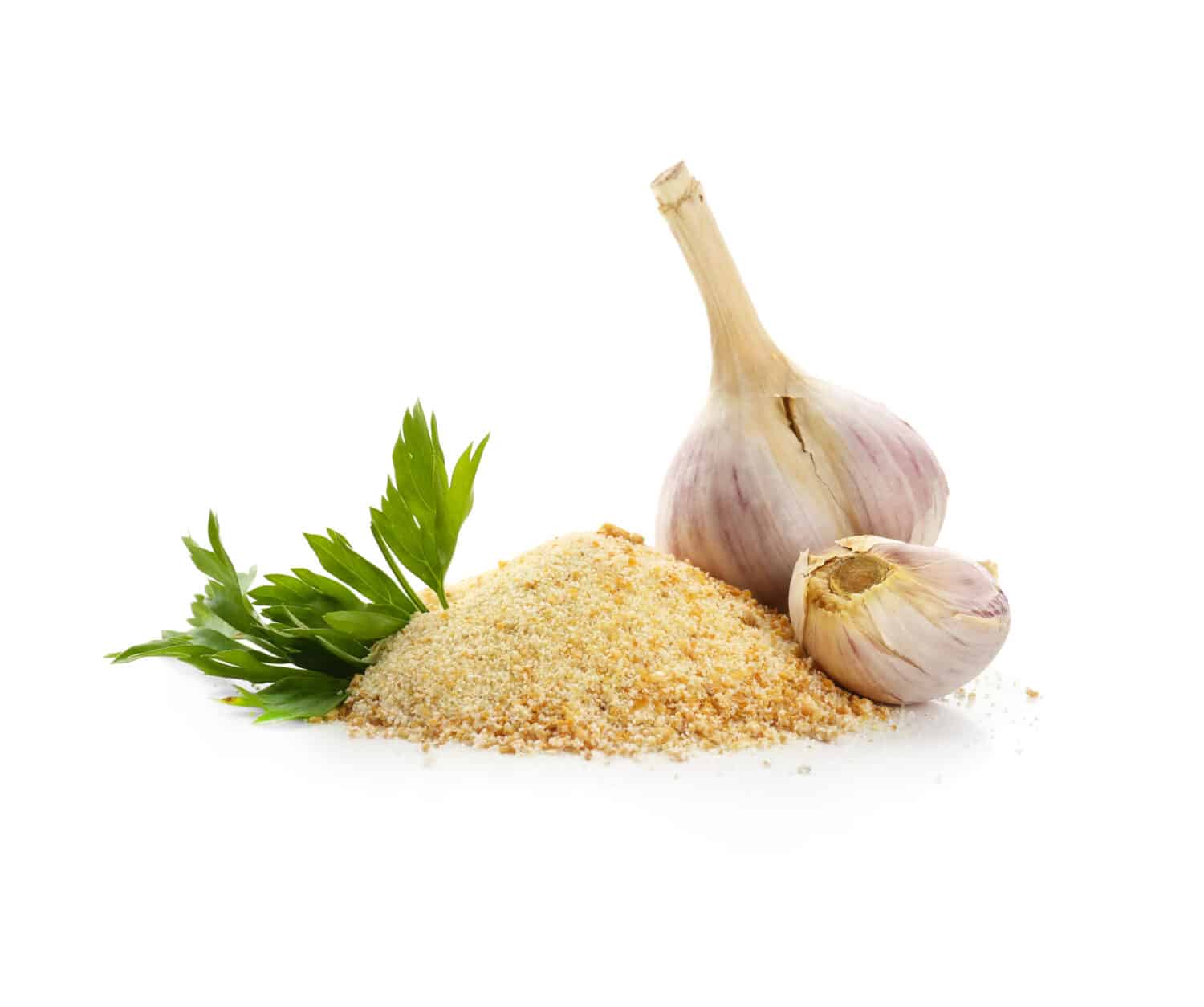Adding some garlic to your meal is a surefire way to add flavor and nuance to many excellent dishes. However, when you don’t have fresh garlic on hand, it can be hard to pick between granulated garlic vs. garlic powder. What even are they, and are they different things? If you’re asking these questions in the spice aisle, you’ve come to the right place. Granulated garlic is a dried, ground form of this flavorful vegetable. Garlic powder, on the other hand, is a more refined form of dried garlic. It’s known for having a potent flavor, being easy to incorporate into dishes, and having a longer shelf-life of the two options. While these two ingredients do come from dried garlic, the texture and potency are really what sets them apart in the kitchen.
In this post, we’ll discuss the history of garlic and how it ended up in powdered forms. You’ll learn some of the best ways to incorporate granulated garlic vs. garlic powder in your meals and get some recipe ideas! The next time you’re in the spice aisle, you’ll march right up to the best garlic for you. Never again will you ponder the major differences between granulated garlic vs. garlic powder. Happy reading!
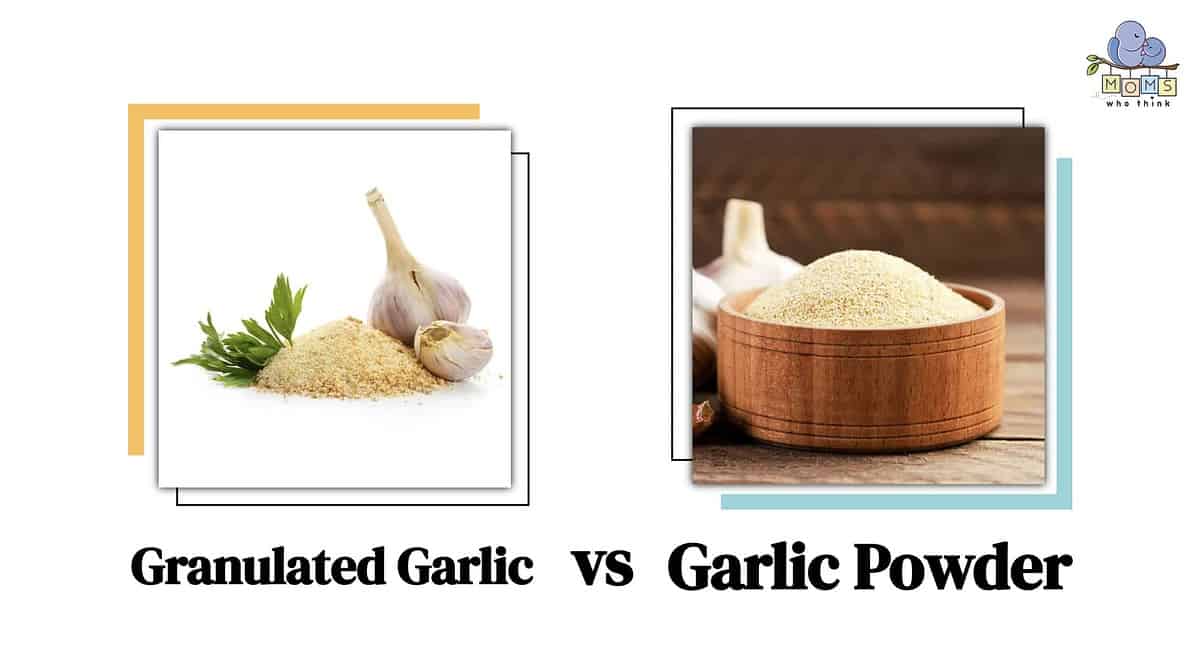
Granulated Garlic vs. Garlic Powder: What's The Difference?
The major differences between these two dried garlic forms come down to texture, shelf-life, and potency in cooking. Granulated garlic has a coarse texture, and overall, the ground-up pieces are larger. Because of this, it can take longer for granulated garlic to be absorbed into a dish, so it requires certain recipes that can properly release the flavors of these garlic granules. Garlic powder, on the other hand, is a fine powdered form of dried garlic. It can add instantaneous flavor to many dishes, and because it dissolves easily, it's a fast way of cooking with dried garlic. Each form is great under specific circumstances, and while they are somewhat interchangeable, let's get into more specifics.
History And Origin Of Garlic
Garlic is one of the oldest crops to be cultivated. It was present in the early diets and cultures of Egyptian and Indian cultures. There are references to garlic bulbs from the Babylonians and the Chinese, dating back 4,000-5,000 years. The wild form of the crop is native to Central Asia, the only place where it freely grows without farming (Tajikistan, Turkmenistan, Kyrgyzstan, and Uzbekistan).
Easy to grow in many kinds of soil, garlic is propagated for its simplicity and appreciated for its long-lasting harvest. Garlic bulbs do not go bad for long periods, making them an easy way to flavor, especially in a time without refrigeration or preservation techniques. It was traded as currency and brought on long journeys. Garlic has held many roles throughout history: a symbol of protection, an herbal remedy, and a dependable flavoring option.
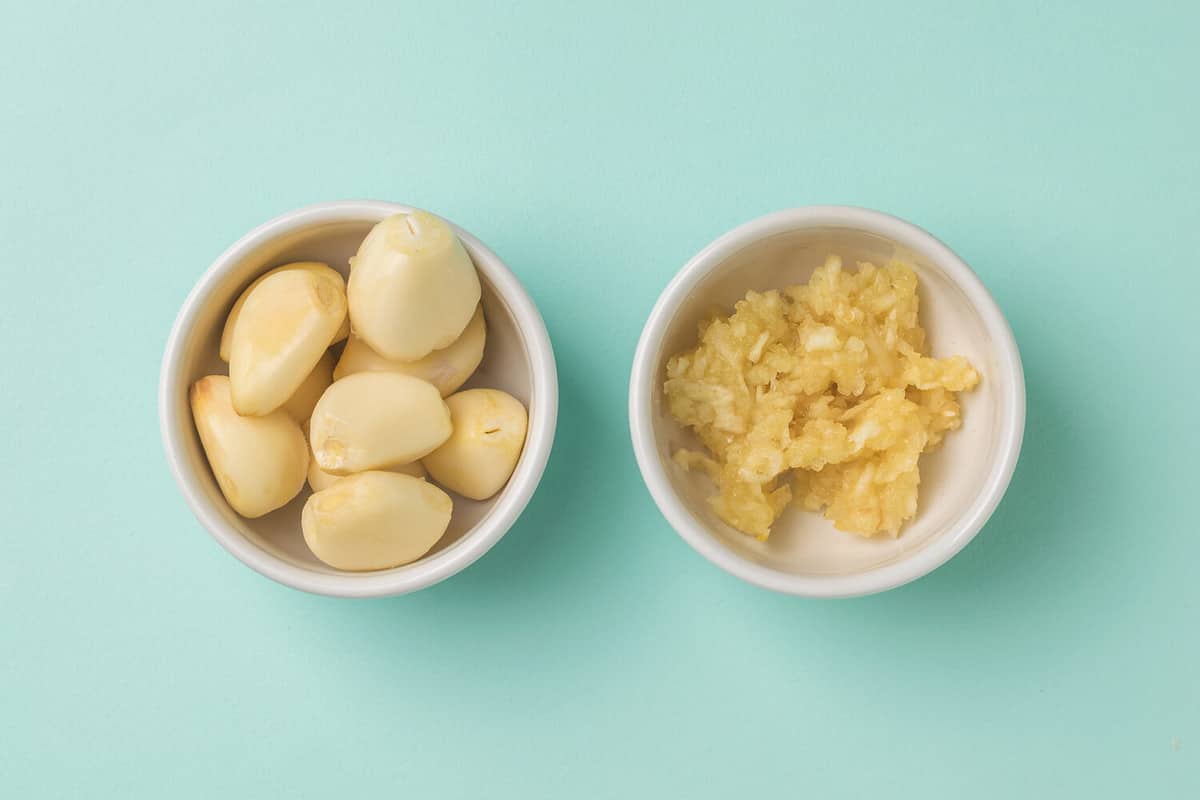
©VLADIMIR VK/Shutterstock.com
What is Granulated Garlic?
Granulated garlic is dried garlic that has been divided into numerous granules that hold much of the flavor of fresh garlic. Its course texture makes it comparable to a corn meal. However, it has a lighter coloration and a crunchy texture. Rehydrating them in dishes is the key to releasing the garlicky flavor of these dried granules (via Specialty Produce).
How Granulated Garlic Is Made
To make granulated garlic, you need fresh garlic that has been dried. You can either find this at the store or do it yourself with the help of an oven or dehydrator. Once dried, coarsely grind the dried garlic into larger granules. This can be done through the process of mincing and further grinding. Be sure to keep some of the larger pieces; you don't want to over-grind the garlic because the coarse granules define this kind of dried garlic ingredient. And it is that simple – just like that, you have granulated garlic. Storebought varieties have more processing steps before bottling, but that is the general basis.
Popular Uses
Granulated garlic does best in longer recipes, so the flavor of the garlic granules can be truly released into the dish. The Washington Post recommends using it in stirfries and meat rubs. You really want to engage with the flavor of the dried garlic, and the best way to do this is with rehydration. Check out some of these recipes where you could substitute fresh garlic and use granulated garlic:
Chicken with Garlic Sauce
Creamy Slow-Cooked Garlic Beef Stroganoff Recipe
Italian Garlic Basil and Herbs Pork Chops Recipe
Broiled Halibut with Garlic-Chive Sour Cream Recipe
What is Garlic Powder?
Garlic powder is a fine-processed form of dried garlic. Think salt crystal fine. Garlic powder is pulverized in a spice grinder and can be made at home but requires a way to grind it up into a fine dusting. It is great for faster recipes to add an immediate boost of flavor. A little will go a long way because it's so fine and concentrated. It dissolves quickly and packs a punch, so be sure you know how much to add!
Popular Uses
Garlic powder can be a great tool in the kitchen, although it used to be considered a lesser way of adding garlic. According to Epicurious, James Beard and Julia Child considered it to be an abomination. In her book In Julia’s Kitchen With Master Chefs, Child described garlic powder as “despised, and abominated among cooks in the know.” While many people prefer to cook with the freshest version of garlic, there's no denying the ease and accessibility of cooking with garlic powder. It only takes a little to go a long way, and garlic powder is essential in some of the best snacks. Check mix, anyone?
Truly, powdered garlic has proven its value in quicker recipes, and adding flavor when tracking down fresh garlic isn't the move. While it will always taste differently than its whole vegetable counterpart, there is absolutely a time and place to use garlic powder and have it be a success. Check out some of these recipes that use garlic powder:
Blue Ribbon Chili Recipe
Butter Chicken Recipe
And keep in mind the many recipes you already make that could benefit from a pinch of garlicky goodness! As we've said before, a little goes a long way, so use your measuring spoons!
Nutritional Value
Check out the nutritional profiles of granulated garlic vs. garlic powder below. As you can see, they're quite comparable, with an increase in calories, and carbohydrates between granulated and powdered forms of the dried vegetable. In general, raw cloves have more protein than both granulated and powdered forms of garlic, but this makes sense as drying garlic and breaking down/powdering it is sure to have some effect on the overall nutritional benefits. Still, these dried garlic forms are often consumed in such small amounts that neither will really have that much of a caloric impact on your diet.
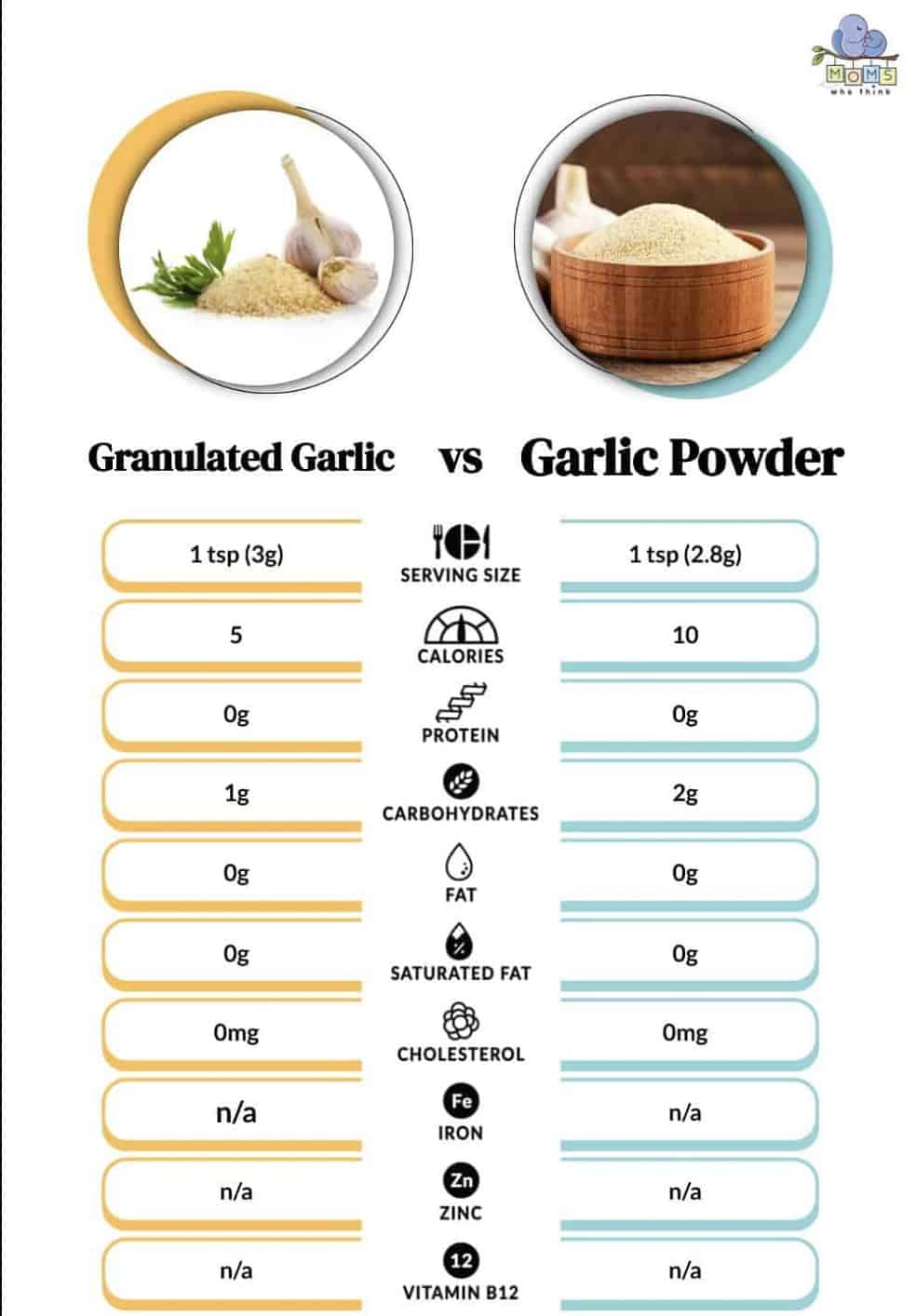
Granulated Garlic vs. Garlic Powder: Are They The Same Thing?
In short, no. These two are not the same thing. Their texture contributes largely to how they can be used in certain dishes, thus changing the overall flavoring. They can be exchanged in a pinch, but you should research exactly how much to add and how this will impact the dish's cooking time. In terms of measurement, a good comparison to understand is that garlic powder is extremely concentrated while granulated garlic is more aerated. One teaspoon of garlic powder is about equal to two teaspoons of granulated garlic (via Majestic Spice).
Possible Alternatives To Granulated Garlic And/Or Garlic Powder
Good alternatives to granulated and powdered forms of garlic include garlic salt and garlic flakes. As ever, the best option for many of these dishes is to use fresh garlic. Fresh garlic comes in 11 groups; these include Asiatic garlic, Middle Eastern garlic, porcelain garlic, artichoke garlic, purple stripe and glazed purple stripe garlic, silverskin, creole, turban, and rocambole varieties. Happy cooking!
Comparison of Granulated Garlic vs. Garlic Powder
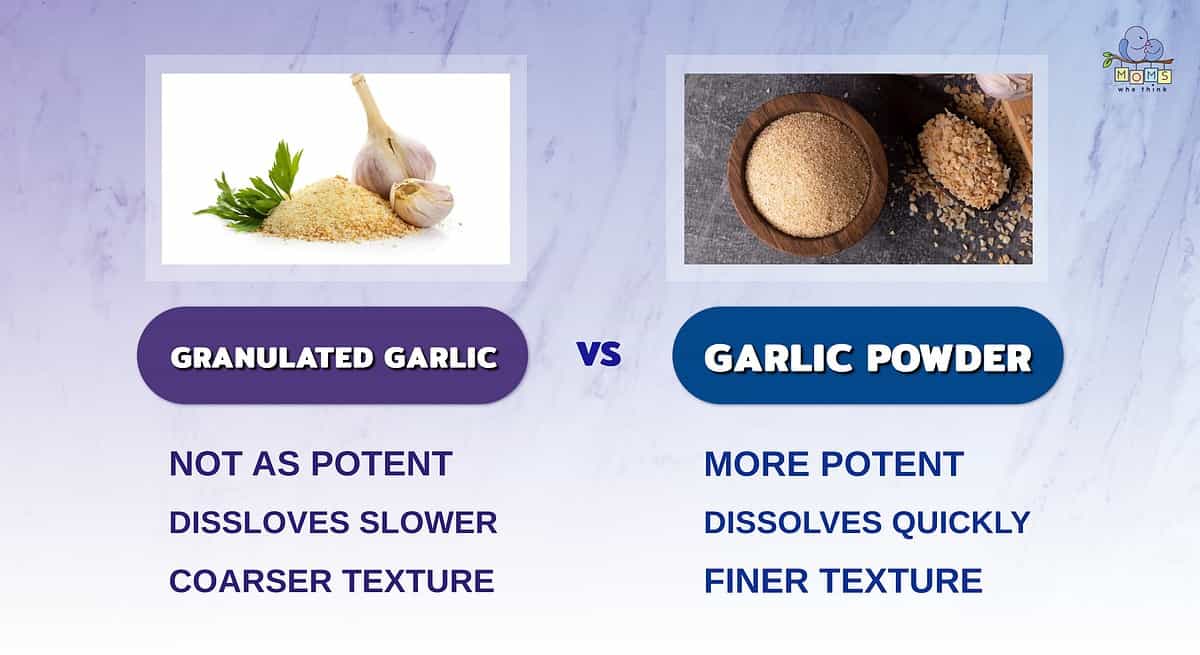
Garlic is one of those vegetables that adds wonderful flavor to countless dishes. And while granulated garlic and garlic powder offer slightly that wonderful garlic taste, they have a few differences. Here's how they differ:
- The most obvious difference is granulated garlic has a coarser texture, while garlic powder has a finer consistency.
- Garlic powder tends to absorb quicker than granulated garlic when cooked in dishes.
- As far as potency, garlic powder is more potent than granulated garlic.
Haven't found a garlic recipe that suits your taste yet? Check out this garlic fried chicken recipe:
PrintGarlic Fried Chicken
Ingredients
2 teaspoons garlic powder, or to taste
1 teaspoon ground black pepper
1 teaspoon salt
1 teaspoon paprika
½ cup seasoned bread crumbs
1 cup all-purpose flour
½ cup milk
1 egg
4 skinless, boneless chicken breast halves – pounded thin
1 cup oil for frying, or as needed
Instructions
1. In a shallow dish, mix together the garlic powder, pepper, salt, paprika, bread crumbs and flour.
2. In a separate dish, whisk together the milk and egg.
3. Heat the oil in an electric skillet set to 350 degrees F.
4. Dip the chicken into the egg and milk, and then dredge in the dry ingredients until evenly coated.
5. Fry chicken in the hot oil for about 5 minutes per side, or until the chicken is cooked through and juices run clear.
6. Remove from the oil with a slotted spatula. Serve with a box of olive oil and garlic pasta and French bread.
The image featured at the top of this post is ©Africa Studio/Shutterstock.com.
